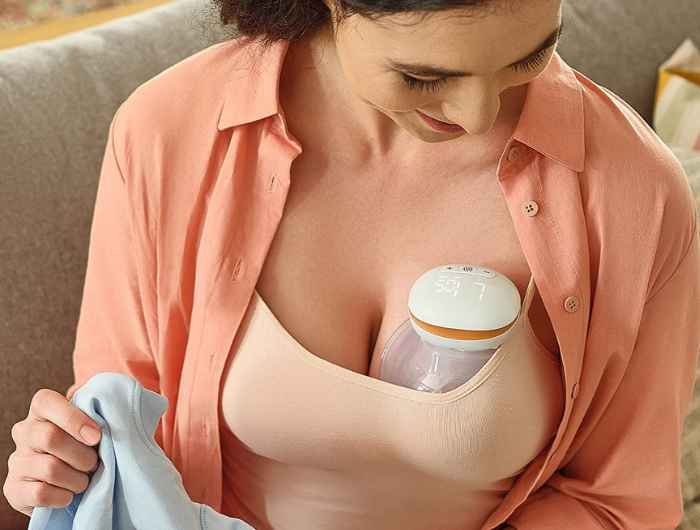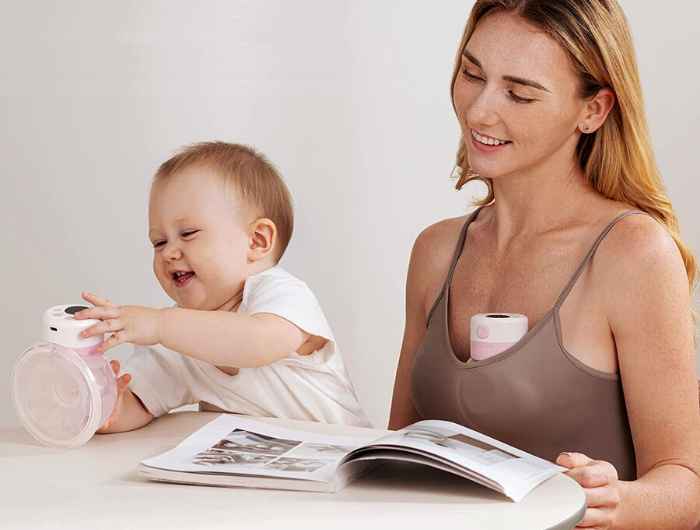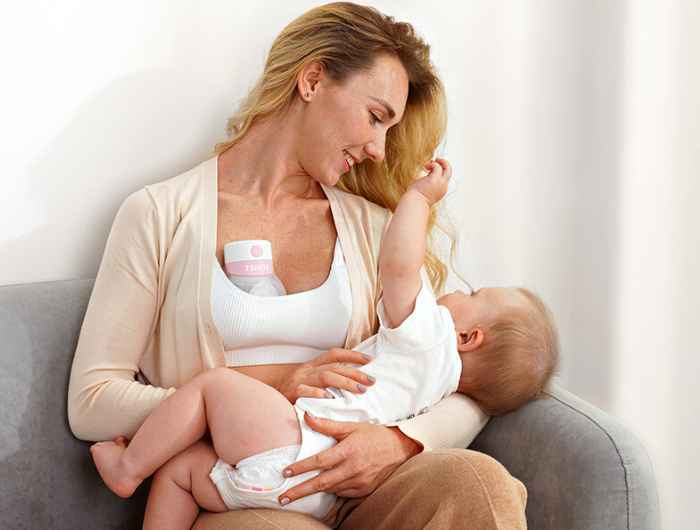When it comes to breastfeeding, many mothers are turning to wearable pumps. These pumps are worn in a bra under clothes and provide hands-free pumping, allowing moms to pump while multitasking.
Wearable pumps have become a convenient helper for breastfeeding moms. But there is still some confusion surrounding their effectiveness in helping maintain the milk supply. Here, we'll dive into the details of how wearable pumps work and their potential impact on milk supply.
Understanding Breast Milk Production
Prolactin is super important for starting and keeping up milk production after a pregnancy. There are many things that can make the body release more prolactin. It's also key to know how oxytocin works because getting the milk out efficiently is a must to keep lactation going.
Factors Affecting Prolactin Levels:
- Frequency of Nursing or Pumping: The more often a baby nurses or a mother pumps, the more prolactin is released. This is why frequent breastfeeding or pumping is recommended to increase milk output.
- Skin-to-Skin Contact: Holding your baby close or practicing skin-to-skin contact can boost prolactin levels, promoting milk production.
- Baby's Sucking Strength: A strong, effective latch and sucking can stimulate more prolactin release.
- Stress: High levels of stress can negatively impact prolactin release, potentially reducing milk supply.
- Sleep: Adequate rest is important for maintaining healthy prolactin levels. Prolactin levels naturally rise during sleep, especially at night.
Factors Affecting Oxytocin Levels:
- Physical Stimulation: Nipple stimulation, either by the baby's sucking or by a breast pump, triggers oxytocin release, causing the milk ejection reflex or "let-down."
- Emotional Triggers: Positive emotions, such as feeling connected and relaxed while nursing or thinking about your baby, can increase oxytocin levels. Hearing your baby cry or thinking about breastfeeding can also trigger this response.
- Comfort and Environment: Being comfortable and relaxed can enhance oxytocin release. A stressful environment may inhibit the release of oxytocin, making it harder for the milk to flow.
- Physical and Emotional Well-being: Overall health, including emotional well-being, can impact oxytocin levels. Support from partners, family, and friends can positively influence these levels.
How Do Wearable Pumps Work?
Wearable pumps use a suction system that mimics your baby's sucking pattern. The pump also allows you to adjust the speed and intensity of the suction based on your comfort level and milk flow.
This means that you can customize the settings to help maximize milk production while still feeling comfortable with the experience. Test different settings to find out how your milk production responds. What works for someone else might not work for you.
Using wearable breast pumps offer convenience and allow for multitasking while pumping. You can move around and do things while being able to pump at the same time.

Does a Wearable Pump Decrease Milk Supply
The short answer is “no” - wearing a pump does not inherently decrease the amount of milk you produce. However, if you're not using it correctly or if it isn't providing sufficient stimulation then it could affect your milk production.
That's why it's important to make sure that you read all instructions carefully before using any kind of pumping device, whether it's a traditional breast pump or a wearable pump.
Additionally, make sure that you adjust the settings according to what works best for you and your body - don't just keep them at one speed for too long as this could result in decreased milk production over time due to reduced stimulation from the suction process.
Other Factors That Impact Milk Supply
It's important to note that while wearable pumps can be beneficial in helping maintain milk supply, they aren't the only factor at play here. Your overall health and lifestyle habits will also affect your ability to produce enough breast milk for your baby.
Drinking plenty of water, eating nutrient-dense meals throughout the day, getting adequate rest, managing stress levels, and maintaining good posture when nursing/pumping are all essential components for successful breastfeeding experiences - regardless of whether or not you decide to use a wearable pump!
What Time Of Day Is Best To Use A Breast Pump
When it comes to breast pumping, the best time of day will depend on your circumstances. Generally speaking, the most effective way to pump is when your breasts are at their fullest. This usually occurs in the morning shortly after you wake up and between feedings during the day.
It’s also important to make sure you're relaxed before you start - stress can affect milk production and may lead to an ineffective session. Once these two criteria are met, scheduling pumping sessions should be relatively easy!
Can You Sleep With A Wearable Breast Pump
Yes, you can sleep with a wearable breast pump at night! Wearing breast pumps while sleeping is becoming increasingly popular among mothers who want to make pumping easier and more convenient. It’s an ideal choice for those wanting more freedom and mobility throughout their day.
When it comes to wearing a breast pump during sleep, there are some important considerations to keep in mind. Firstly, you must ensure the device fits properly around your chest and that you feel comfortable wearing it during sleep—it should not be too tight or restrictive on your body.
Secondly, consider using a night light attachment so that the sound of the pump motor won’t disturb your child if it is also sleeping nearby. Finally, note that different brands (elvie stride, spectra s1, willow pump) offer varying hands-free design features for nighttime wear; choose one that best suits your needs and lifestyle to minimize potential disruption during rest time.
Pros and Cons of Wearable Breast Pumps
Deciding if wearable breast pumps are a good fit for you means looking at both their benefits and potential downsides in relation to your nursing needs.
Pros
- Mobility and Freedom: These pumps are great for active moms. Whether you're exercising, shopping, or just out for a stroll, wearable pumps offer unparalleled freedom.
- Privacy: Thanks to their integrated design, you can pump in public without worrying about tubes or setups that draw attention.
- Ease of Use and Cleaning: Many models are designed to be user-friendly, featuring easy to assemble and disassemble parts that are often dishwasher-safe, making them easy to clean.
Cons
- Variations in Suction and Efficiency: Every mom and every pumping session is unique. Some may find that wearable pumps don't always provide the same level of suction or efficiency needed for maximum milk extraction.
- Securing the Perfect Fit: Comfort is crucial, and finding it depends on getting the right flange size and placement with a wearable pump. A flange that doesn't fit well can reduce both comfort and the pump's effectiveness, which might affect milk supply.
- Cost Considerations: Wearable pumps usually have a higher upfront cost compared to traditional pumps. It's also important to factor in the price of any extra accessories or replacement parts when thinking about the overall investment.

Conclusion
Using a wearable pump does not have to decrease your milk supply. However, if you do not use the pump correctly this may impact your milk production over time. If the suction power and speed settings don't match your body's needs, it can reduce stimulation and therefore milk supply over time.
There are many pumps on the market, so make sure to research carefully which pump you choose.
Other factors such as overall health and lifestyle habits play also an important role in successful breastfeeding outcomes. Therefore mamas should ensure they are taking care of themselves both physically and mentally throughout their journey toward successful motherhood!
Thank you for reading Mother Bear Reviews, your favorite parenting blog!








